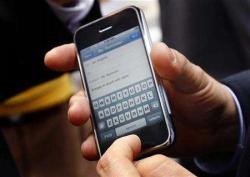Marc Saltzman
Sun
After playing around with a sleek iPhone 3G for eight days, I can confirm it lives up to its hype. But it’s not a flawless gadget, nor is it an inexpensive one when you factor in that the regular minimum investment is almost $2,500 over three years for the non-promotional data and voice plan.
What’s new? As the name suggests, the iPhone 3G takes advantage of Rogers‘ HSPA (“Vision”) 3G network for broadband-like cellphone speeds across Canada. This means you can surf and download without having to find a wireless hot spot at a cafe or airport lounge (though Wi-Fi is still included in the new iPhone, and is generally faster than 3G).
The 3G designation stands for third generation, a faster wireless network technology than the original model used. Built-in GPS technology and the Google Maps application mean the iPhone can help you get to where you’re going — even with satellite photo views on its bright 3.5-inch screen (measured diagonally). And it’s not just for navigation to your destination, but to spots in between such as restaurants, bank machines or gas stations. Feel like a cup of joe when you’re walking around town? Use your fingertip to type the word “coffee” in the search field and you’ll immediately see push-pins near your location on the overhead map, showing the closest cafes with turn-by-turn directions. There’s no audio, though, so it’s not ideal while driving.
For the mobile business person, the iPhone’s Mac-based operating system now supports Microsoft’s Exchange ActiveSync platform, allowing iPhone users to synchronize e-mail, calendars, tasks and contacts with their company’s secure Microsoft Exchange Server. Another major new feature — one we weren’t able to test-drive because it won’t be live until Friday — is the AppStore. Users will be able to download thousands of third-party applications to customize the iPhone’s functionality. Battery life is quite impressive on the iPhone 3G. I used the handset for four days straight without charging it once, and that included chatting, Wi-Fi web surfing and e-mail.
What’s not to love? With a reported 100 new features added to the original iPhone, the iPhone 3G (available in black or white) builds nicely on its mega-popular predecessor. But it’s still missing a few key features. There is still no video camera function in the iPhone 3G (something I enjoy using on my BlackBerry Curve) and the camera remains at two megapixels rather than matching the quality of those offered by other phone makers, such as Sony Ericsson and Nokia. Speaking of photos, you can e-mail a photo you’ve taken to someone but you can’t send it to another phone via MMS (multimedia messaging service), as you can with many other phones.
Curiously, the iPhone 3G also doesn’t have a voice recorder, nor does it offer voice-activated dialing. Other beefs include the inability to cut and paste text (say, from a website to a document) and you can’t access the wireless iTunes store over 3G (Wi-Fi only). Finally, the “soft” keyboard takes some time getting used to — especially for BlackBerry users — and it’s too bad you can’t turn the iPhone horizontally when typing an e-mail to make the keyboard bigger.
The biggest issue, though, has nothing to do with the iPhone itself. The main concern for many is the cost of the Rogers or Fido data plans and the limitations put on usage. Canadians won’t have an “unlimited” usage option with the iPhone 3G.
© The Vancouver Sun 2008










